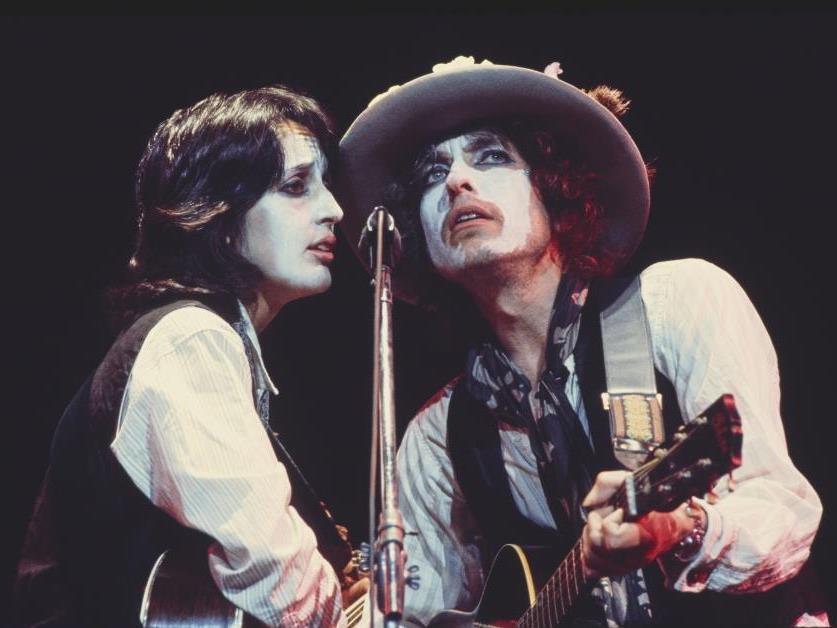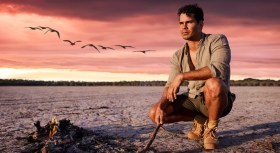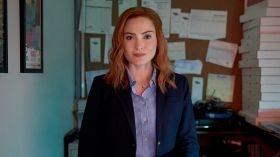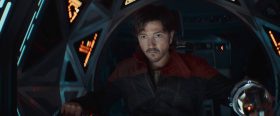Masks and disguises aplenty. Rolling Thunder Revue: A Bob Dylan Story by Martin Scorsese. Credit: Netflix.
For any Bob Dylan fan – and I certainly count myself in that group – the immediate and overriding response to Martin Scorsese’s latest documentary on the singer-songwriter, Rolling Thunder Revue, has got to be: what’s not to like? The songs are great, the performances inspired, and the heady atmosphere of this peak period in Dylan’s 1970s career is infectiously captured. Dylan had reached back into his folk-club roots of the early ‘60s, mixed in some newer blood, and assembled a loose, ever-expanding, touring ensemble (from October 1975 to May 1976) that avoided the big rock stadiums and evoked an old-style musical “revue”. Scorsese has not only given us a generous (at 142 minutes) assemblage of the available materials, he has also given it a decent digital brush-up in picture and sound quality.
In many ways and on many levels, the film is simply another part of the relentless campaign of Dylan and his manager Jeff Rosen to revive, restore and release the “official bootleg” archive of the artist. Hidden not far below the surface of this merry Netflix spectacle, however, are a few intriguing questions.
Subtitled “A Bob Dylan Story by Martin Scorsese”, Rolling Thunder Revue has aroused most comment, so far, for its fancy fictional contrivances: inserting a young Sharon Stone into the tour, for instance … and even an entirely imaginary character, the titular politician (played by Michael Murphy) from Robert Altman’s satirical series Tanner ‘88 (1988) and its sequel, Tanner on Tanner (2004). There is no real deceit going in in this sleight-of-hand: Scorsese begins the whole show, after all – and I suspect this is among his few truly personal contributions to the project – with a clip from a silent, magic-trick film by Georges Méliès (thus linking it to his Hugo, 2011), and he ends it with footage of a “compere” in a mask.
Dylan has long claimed the freedom to turn his past life into whatever story he pleases, and to project any image of himself that he chooses – which is no doubt why he approved of Todd Haynes’ cubistic, “many Dylans” approach to the biopic I’m Not There (2007) – the weakest part of which was, curiously, the Richard Gere strand supposedly evoking the Rolling Thunder/Pat Garrett and Billy the Kid mid ‘70s period. Dylan is fully part of the storytelling game in Rolling Thunder Revue, verifying (for instance) that the white stage make-up he and his collaborators wore was in homage to the band Kiss – something that is probably not true at all.
So far, it’s a harmless prank. Things get murkier for me, however, once Dylan starts talking about the mysterious documentary filmmaker Stefan Van Dorp who was also along for the tour, shoving his camera in everywhere – and whom we occasionally hear Dylan berate as he mutters at someone off-screen in the archival footage. Dorp is played by performance artist Martin Von Haselberg, so he doesn’t really exist – everything about him has been faked up. There’s an odd moment near the end of Rolling Thunder Revue where Dorp castigates his off-screen interviewer: “I’m the one who made this, you’re using it – this wouldn’t exist without me, I’m the filmmaker here”. More than any of the other jokey contrivances scattered throughout Scorsese’s film, this Mr. Dorp is a device, designed to cover something up. But who or what, exactly?
It has been astonishing to me to see how many reviewers of Rolling Thunder Revue seem almost entirely unaware that it has been built on the remains of another, earlier film: Dylan’s own Renaldo & Clara, released in two different versions (4 hours and then 2 hours) in 1978, and last shown officially on UK’s Channel 4 in the early ‘80s. Two myths have done the rounds in rapid succession since the release of Scorsese’s film: that it’s best never to have seen Renaldo & Clara, because it was a pretentious, lousy mess, and that Rolling Thunder Revue is built in part from its leftover “outtakes”. In fact, it’s much more than outtakes: it looks to me as if all the many hours of footage gathered for Renaldo & Clara, used or unused for Dylan’s longest cut, has been put at the disposal of Scorsese and his collaborators, including editors Damian Rodriguez and David Tedeschi. This means that most of the sections that have come around for special praise or attention in Scorsese’s compilation – such as a scene of Allen Ginsberg reciting poetry to a room of elderely citizens, or a touching moment at Jack Kerouac’s grave, not to mention the entirety of the concert footage – were all originally staged and (more or less) directed by Dylan. The trickster is playing his mirror-games to deflect this fact. Why?
In his “Bradlands” column for Sight and Sound, the critic Brad Stevens, among the staunchest defenders of Renaldo & Clara, described its incessant and often ambiguous slides between documentary and fiction: “The breaking down of categories is the film’s structural principle, with none of these elements existing independently of the others. And this ambitious structure reinforces what is clearly Dylan’s central concern: the blurring of lines between one identity and another”. Identity is indeed the key: Dylan is many people in it, and many others assume the role of “Bob Dylan”! And I agree with Stevens: longueurs, obscurities and all, it’s a pretty remarkable film experiment, easily on par with, or well above the quality of, similar musician-turned-filmmaker efforts by Neil Young, David Byrne, Frank Zappa and others.
Why has Dylan so ruthlessly suppressed his own film, and now woven an elaborate “myth” to obscure its very existence? (Even the title Renaldo & Clara appears nowhere in the end credits of Rolling Thunder Revue.) The reason seems clear: the marital divorce between him and Sara Noznisky – even the famous song in her name, “Sara”, gets no play in Rolling Thunder Revue. Perhaps due to legal agreements in their divorce settlement of 1977, Sara has been erased entirely from Scorsese’s film, as have their children. (The same erasure happened in the sole volume to date of Dylan’s written autobiography, Chronicles.) This is quite a disappearance, considering that she is among the main players in Renaldo & Clara, and that the film is, in no small part, a reflection on their marital crisis. If one believes the better biographies of Dylan, it was the experience of this tour that essentially put the nail in the coffin of their union.
Although I have been conventionally signalling Scorsese as the auteur of Rolling Thunder Revue, we need to be a little careful with this attribution. As was the case with the previous Dylan-Scorsese doco, No Direction Home (2005, detailing the period 1961-1966), much of it – including interviews with people who died some time ago, such as Sam Shepard and Rubin Carter (the subject of “Hurricane”) – seems to have been engineered by the aforementioned Jeff Rosen. No doubt Scorsese added his special touches, and oversaw the general assemblage. But even where his hand is most evident – in the montage flurries designed to convey the zeitgeist of the mid ‘70s in USA – there is the hint of an evasion, an ulterior motive at work. It is odd and disconcerting to hear Dylan, as he is today, recalling at the start of Rolling Thunder Revue that “America was chased out of Vietnam in such a humiliating way”. What? The strong political level of Renaldo & Clara (reminiscent of Scorsese’s own early Street Scenes, 1970) is, in a single stroke, disposed of here. Dylan lurched mightily from left to right in the period immediately following the Rolling Thunder tour – I love his music, but let’s not forget that this is the guy who stood on stage at Live Aid in 1985 and suggested that “one or two million” be taken from “the money that’s raised for people in Africa” and given to American farmers! For someone who has travelled the wide world so many times, Dylan is surely a first-class myopic All-American. And now Rolling Thunder Revue helps to bolster that particular, conservative myth of his ever-rewritten self.
One person, in particular, has sadly disappeared as a result of all this fiddling with the records of the past: Dylan’s close cinematic collaborator in the 1960s and ‘70s, Howard Alk. His biography is shadowy but fascinating: a comedian in his youth alongside Elaine May and Mike Nichols, he coined at least one immortal stand-up line: the definition of a Freudian slip as “meaning to say one thing and saying a mother”. Alk assisted on the classic Dylan documentary Don’t Look Back (1967), and was both a cinematographer and co-editor of Renaldo & Clara; he also directed several other political films with titles like American Revolution. But he died at age 52 of a drug overdose in 1982, and cultural history has not been kind to him. In fact, he has been ungraciously “submerged” twice now. When No Direction Home appeared, much was made of the unearthed, previously “lost” colour footage shot by the celebrated D.A. Pennebaker that Scorsese was able to draw upon. But that very footage had already been the basis of another “bootleg” production never made officially available: Eat the Document (1968), a savage “mockumentary” well before its time, even a veritable anti-documentary, edited by Dylan and Alk. “Eating the document” has turned out to be something that Dylan manages to do very well indeed, along with all his high-level co-conspirators.
© Adrian Martin, July 2019
|
3 stars
|
★★★
|
Rolling Thunder Revue: A Bob Dylan Story by Martin Scorsese
Director: Martin Scorsese
USA, 2019, 2hr 22min
Distributor: Netflix
Rated: M
Release date: 11 June 2019
Actors:
Director:
Format:
Country:
Release:





